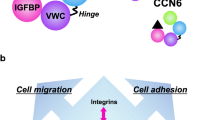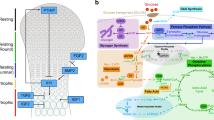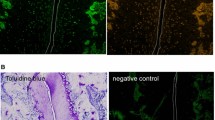Abstract
Cellular communication network factor (CCN) 3, which is one of the founding members of the CCN family, displays diverse functions. However, this protein generally represses the proliferation of a variety of cells. Along with skeletal development, CCN3 is produced in cartilaginous anlagen, growth plate cartilage and epiphysial cartilage. Interestingly, CCN3 is drastically induced in the growth plates of mice lacking CCN2, which promotes endochondral ossification. Notably, chondrocytes in these mutant mice with elevated CCN3 production also suffer from impaired glycolysis and energy metabolism, suggesting a critical role of CCN3 in cartilage metabolism. Recently, CCN3 was found to be strongly induced by impaired glycolysis, and in our study, we located an enhancer that mediated CCN3 regulation via starvation. Subsequent investigations specified regulatory factor binding to the X-box 1 (RFX1) as a transcription factor mediating this CCN3 regulation. Impaired glycolysis is a serious problem, resulting in an energy shortage in cartilage without vasculature. CCN3 produced under such starved conditions restricts energy consumption by repressing cell proliferation, leading chondrocytes to quiescence and survival. This CCN3 regulatory system is indicated to play an important role in articular cartilage maintenance, as well as in skeletal development. Furthermore, CCN3 continues to regulate cartilage metabolism even during the aging process, probably utilizing this regulatory system. Altogether, CCN3 seems to prevent “overwork” by chondrocytes to ensure their sustainable life in cartilage by sensing energy metabolism. Similar roles are suspected to exist in relation to systemic metabolism, since CCN3 is found in the bloodstream.
Graphical Abstract



Similar content being viewed by others
References
Abd El Kader T, Kubota S, Nishida T, Hattori T, Aoyama E, Janune D, Hara ES, Ono M, Tabata Y, Kuboki T, Takigawa M (2014) The regenerative effects of CCN2 independent modules on chondrocytes in vitro and osteoarthritis models in vivo. Bone 59:180–188
Akashi S, Nishida T, El-Seoudi A, Takigawa M, Iida S, Kubota S (2018) Metabolic regulation of the CCN family genes by glycolysis in chondrocytes. J Cell Commun Signal 12:245–252
Akashi S, Nishida T, Mizukawa T, Kawata K, Takigawa M, Iida S, Kubota S (2020) Regulation of cellular communication factor 2 (CCN2) in breast cancer cells via the cell-type dependent interplay between CCN2 and glycolysis. J Oral Biosci 62:280–288
Asano M, Kubota S, Nakanishi T, Nishida T, Yamaai T, Yosimichi G, Ohyama K, Sugimoto T, Murayama Y, Takigawa M (2005) Effect of connective tissue growth factor (CCN2/CTGF) on proliferation and differentiation of mouse periodontal ligament-derived cells. Cell Commun Signal 3:11
Benini S, Perbal B, Zambelli D, Colombo MP, Manara MC, Serra M, Parenza M, Martinez V, Picci P, Scotlandi K (2005) In Ewing’s sarcoma CCN3 (NOV) inhibits proliferation while promoting migration and invasion of the same cell type. Oncogene 24:4349–4361
Bleau AM, Planque N, Lazar N, Zambelli D, Ori A, Quan T, Fisher G, Scotlandi K, Perbal B (2007) Antiproliferative activity of CCN3: involvement of the C-terminal module and post-translational regulation. J Cell Biochem 101:1475–1491
Bork P (1993) The modular architecture of a new family of growth regulators related to connective tissue growth factor. FEBS Lett 327:125–130
Bradham DM, Igarashi A, Potter RL, Grotendorst GR (1991) Connective tissue growth factor: a cysteine-rich mitogen secreted by human vascular endothelial cells is related to the SRC-induced immediate early gene product CEF-10. J Cell Biol 114:1285–1294
Brigstock DR, Goldschmeding R, Katsube KI, Lam SC, Lau LF, Lyons K, Naus C, Perbal B, Riser B, Takigawa M, Yeger H (2003) Proposal for a unified CCN nomenclature. Mol Pathol 56:127–128
Fujisawa T, Hattori T, Ono M, Uehara J, Kubota S, Kuboki T, Takigawa M (2008) CCN family 2/connective tissue growth factor (CCN2/CTGF) stimulates proliferation and differentiation of auricular chondrocytes. Osteoarthr Cartil 16:787–795
Grotendorst GR, Duncan MR (2005) Individual domains of connective tissue growth factor regulate fibroblast proliferation and myofibroblast differentiation. FASEB J 19:729–738
Gupta N, Wang H, McLeod TL, Naus CC, Kyurkchiev S, Advani S, Yu J, Perbal B, Weichselbaum RR (2001) Inhibition of glioma cell growth and tumorigenic potential by CCN3 (NOV). Mol Pathol 54:293–299
Gupta R, Hong D, Iborra F, Sarno S, Enver T (2007) NOV (CCN3) functions as a regulator of human hematopoietic stem or progenitor cells. Science 316:590–593
Gupta R, Turati V, Brian D, Thrussel C, Wilbourn B, May G, Enver T (2020) Nov/CCN3 enhances cord blood engraftment by rapidly recruiting latent human stem cell activity. Cell Stem Cell 26:527–541
Henrot P, Moisan F, Laurent P, Manicki P, Kaulanjan-Checkmodine P, Jolivel V, Rezvani HR, Leroy V, Picard F, Boulon C, Schaeverbeke T, Seneschal J, Lazaro E, Taïeb A, Truchetet ME, Cario M (2020) Decreased CCN3 in systemic sclerosis endothelial cells contributes to impaired angiogenesis. J Invest Dermatol 140:1427–1434
Hirose K, Kuwahara M, Nakata E, Tetsunaga T, Yamada K, Saiga K, Takigawa M, Ozaki T, Kubota S, Hattori T (2022) Elevated expression of CCN3 in articular cartilage induces osteoarthritis in hip joints irrespective of age and weight bearing. Int J Mol Sci 23:15311
Hollander JM, Zeng L (2019) The emerging role of glucose metabolism in cartilage development. Curr Osteoporos Rep 17:59–69
Huang X, Ni B, Mao Z, Xi Y, Chu X, Zhang R, Ma X, You H (2019) NOV/CCN3 induces cartilage protection by inhibiting PI3K/AKT/mTOR pathway. J Cell Mol Med 23:7525–7534
Ivkovic S, Yoon BS, Popoff SN, Safadi FF, Libuda DE, Stephenson RC, Daluiski A, Lyons KM (2003) Connective tissue growth factor coordinates chondrogenesis and angiogenesis during skeletal development. Development 130:2779–2791
Janune D, Kubota S, Lazar N, Perbal B, Iida S, Takigawa M (2011a) CCN3-mediated promotion of sulfated proteoglycan synthesis in rat chondrocytes from developing joint heads. J Cell Commun Signal 5:167–171
Janune D, Kubota S, Nishida T, Kawaki H, Perbal B, Iida S, Takigawa M (2011b) Novel effects of CCN3 that may direct the differentiation of chondrocytes. FEBS Lett 585:3033–3040
Janune D, Abd El Kader T, Aoyama E, Nishida T, Tabata Y, Kubota S, Takigawa M (2017) Novel role of CCN3 that maintains the differentiated phenotype of articular cartilage. J Bone Miner Metab 35:582–597
Joliot V, Martinerie C, Dambrine G, Plassiart G, Brisac M, Crochet J, Perbal B (1992) Proviral rearrangements and overexpression of a new cellular gene (nov) in myeloblastosis-associated virus type 1-induced nephroblastomas. Mol Cell Biol 12:10–21
Kawaki H, Kubota S, Suzuki A, Lazar N, Yamada T, Matsumura T, Ohgawara T, Maeda T, Perbal B, Lyons KM, Takigawa M (2008) Cooperative regulation of chondrocyte differentiation by CCN2 and CCN3 shown by a comprehensive analysis of the CCN family proteins in cartilage. J Bone Miner Res 23:1751–1764
Kocialkowski S, Yeger H, Kingdom J, Perbal B, Schofield PN (2001) Expression of the human NOV gene in first trimester fetal tissues. Anat Embryol 203:417–427
Kothapalli D, Grotendorst GR (2000) CTGF modulates cell cycle progression in cAMP-arrested NRK fibroblasts. J Cell Physiol 182:119–126
Kubota S (2023) Utilizing public molecular biological databases for CCN family research. Methods Mol Biol 2582:169–187
Kubota S, Takigawa M (2007) CCN family proteins and angiogenesis: from embryo to adulthood. Angiogenesis 10:1–11
Kubota S, Takigawa M (2013) The CCN family acting throughout the body: recent research developments. Biomol Concepts 4:477–494
Kubota S, Takigawa M (2015) Cellular and molecular actions of CCN2/CTGF and its role under physiological and pathological conditions. Clin Sci 128:181–196
Kubota S, Maeda-Uematsu A, Nishida T, Takigawa M (2015) New functional aspects of CCN2 revealed by trans-omic approaches. J Oral Biosci 57:37–43
Kubota S, Kawaki H, Perbal B, Kawata K, Hattori T, Nishida T (2021) Cellular communication network factor 3 in cartilage development and maintenance. J Cell Commun Signal 15:533–543
Kubota S, Kawata K, Hattori T, Nishida T (2022a) Molecular and genetic interactions between CCN2 and CCN3 behind their Yin–Yang collaboration. Int J Mol Sci 24:5887
Kubota S, Aoyama E, Takigawa M, Nishida T (2022b) Fibroblast growth factors and cellular communication network factors: intimate interplay by the founding members in cartilage. Int J Mol Sci 23:8592
Kuwahara M, Kadoya K, Kondo S, Fu S, Miyake Y, Ogo A, Ono M, Furumatsu T, Nakata E, Sasaki T, Minagi S, Takigawa M, Kubota S, Hattori T (2020) CCN3 (NOV) drives degradative changes in aging articular cartilage. Int J Mol Sci 21:7556
Lau LF (2016) Cell surface receptors for CCN proteins. J Cell Commun Signal 10:121–127
Leask A (2009) Yin and Yang: CCN3 inhibits the pro-fibrotic effects of CCN2. J Cell Commun Signal 3:161–162
Leask A, Abraham DJ (2006) All in the CCN family: essential matricellular signaling modulators emerge from the bunker. J Cell Sci 119:4803–4810
Li JY, Wang YD, Qi XY, Ran L, Hong T, Yang J, Yan B, Liao ZZ, Liu JH, Xiao XH (2019) Serum CCN3 levels are increased in type 2 diabetes mellitus and associated with obesity, insulin resistance and inflammation. Clin Chim Acta 494:52–57
Lin CG, Leu SJ, Chen N, Tebeau CM, Lin SX, Yeung CY, Lau LF (2003) CCN3 (NOV) is a novel angiogenic regulator of the CCN protein family. J Biol Chem 278:24200–24208
Maeda-Uematsu A, Kubota S, Kawaki H, Kawata K, Miyake Y, Hattori T, Nishida T, Moritani N, Lyons KM, Iida S, Takigawa M (2014) CCN2 as a novel molecule supporting energy metabolism of chondrocytes. J Cell Biochem 115:854–865
Mizukawa T, Nishida T, Akashi S, Kawata K, Kikuchi S, Kawaki H, Takigawa M, Kamioka H, Kubota S (2021) RFX1-mediated CCN3 induction that may support chondrocyte survival under starved conditions. J Cell Physiol 236:6884–6896
Murase Y, Hattori T, Aoyama E, Nishida T, Maeda-Uematsu A, Kawaki H, Lyons KM, Sasaki A, Takigawa M, Kubota S (2016) Role of CCN2 in amino acid metabolism of chondrocytes. J Cell Biochem 117:927–937
Nakanishi T, Nishida T, Shimo T, Kobayashi K, Kubo T, Tamatani T, Tezuka K, Takigawa M (2000) Effects of CTGF/Hcs24, a product of a hypertrophic chondrocyte-specific gene, on the proliferation and differentiation of chondrocytes in culture. Endocrinology 141:264–273
Nishida T, Nakanishi T, Asano M, Shimo T, Takigawa M (2000) Effects of CTGF/Hcs24, a hypertrophic chondrocyte-specific gene product, on the proliferation and differentiation of osteoblastic cells in vitro. J Cell Physiol 184:197–206
Nishida T, Kubota S, Nakanishi T, Kuboki T, Yosimichi G, Kondo S, Takigawa M (2002) CTGF/Hcs24, a hypertrophic chondrocyte-specific gene product, stimulates proliferation and differentiation, but not hypertrophy of cultured articular chondrocytes. J Cell Physiol 192:55–63
Nishida T, Kubota S, Kojima S, Kuboki T, Nakao K, Kushibiki T, Tabata Y, Takigawa M (2004) Regeneration of defects in articular cartilage in rat knee joints by CCN2 (connective tissue growth factor). J Bone Miner Res 19:1308–1319
Pandey DP, Lappano R, Albanito L, Madeo A, Maggiolini M, Picard D (2009) Estrogenic GPR30 signalling induces prolifer-ation and migration of breast cancer cells through CTGF. EMBO J 28:523–532
Perbal B (2001) NOV (nephroblastoma overexpressed) and the CCN family of genes: structural and functional issues. Mol Pathol 54:57–79
Perbal B (2004) CCN proteins: multifunctional signalling regulators. Lancet 363:62–64
Perbal B, Tweedie S, Bruford E (2018) The official unified nomenclature adopted by the HGNC calls for the use of the acronyms, CCN1-6, and discontinuation in the use of CYR61, CTGF, NOV and WISP 1–3 respectively. J Cell Commun Signal 12:625–629
Riser BL, Najmabadi F, Perbal B, Rambow JA, Riser ML, Sukowski E, Yeger H, Riser SC, Peterson DR (2010) CCN3/CCN2 regulation and the fibrosis of diabetic renal disease. J Cell Commun Signal 4:39–50
Shimo T, Nakanishi T, Nishida T, Asano M, Kanyama M, Kuboki T, Tamatani T, Tezuka K, Takemura M, Matsumura T, Takigawa M (1999) Connective tissue growth factor induces the proliferation, migration, and tube formation of vascular endothe-lial cells in vitro, and angiogenesis in vivo. J Biochem 126:137–145
Sugiaman-Trapman D, Vitezic M, Jouhilahti EM, Mathelier A, Lauter G, Misra S, Daub CO, Kere J, Swoboda P (2018) Characterization of the human RFX transcription factor family by regulatory and target gene analysis. BMC Genomics 19:181
Takigawa M (2013) CCN2: a master regulator of the genesis of bone and cartilage. J Cell Commun Signal 7:191–201
Takigawa M (2018) An early history of CCN2/CTGF research: the road to CCN2 via hcs24, ctgf, ecogenin, and regenerin. J Cell Commun Signal 12:253–264
Twigg SM (2018) Regulation and bioactivity of the CCN family of genes and proteins in obesity and diabetes. J Cell Commun Signal 12:359–368
van Roeyen CR, Eitner F, Scholl T, Boor P, Kunter U, Planque N, Gröne HJ, Bleau AM, Perbal B, Ostendorf T, Floege J (2008) CCN3 is a novel endogenous PDGF-regulated inhibitor of glomerular cell proliferation. Kidney Int 73:86–94
Xie JJ, Xu LY, Wu JY, Shen ZY, Zhao Q, Du ZP, Lv Z, Gu W, Pan F, Xu XE, Xie D, Li EM (2010) Involvement of CYR61 and CTGF in the fascin-mediated proliferation and invasiveness of esophageal squamous cell carcinomas cells. Am J Pathol 176:939–951
Acknowledgements
The authors would like to thank Ms. Yoshiko Miyake for her secretarial assistance. This study was supported by JSPS KAKENHI Grant Nos. JP19H03817, JP20K20611, JP21H03105 and JP21K19603.
Author information
Authors and Affiliations
Corresponding author
Ethics declarations
Conflict of interest
The authors declare that they have no conflict of interest.
Additional information
Publisher's Note
Springer Nature remains neutral with regard to jurisdictional claims in published maps and institutional affiliations.
Rights and permissions
Springer Nature or its licensor (e.g. a society or other partner) holds exclusive rights to this article under a publishing agreement with the author(s) or other rightsholder(s); author self-archiving of the accepted manuscript version of this article is solely governed by the terms of such publishing agreement and applicable law.
About this article
Cite this article
Kubota, S., Kawaki, H., Perbal, B. et al. Do not overwork: cellular communication network factor 3 for life in cartilage. J. Cell Commun. Signal. 17, 353–359 (2023). https://doi.org/10.1007/s12079-023-00723-4
Received:
Accepted:
Published:
Issue Date:
DOI: https://doi.org/10.1007/s12079-023-00723-4




